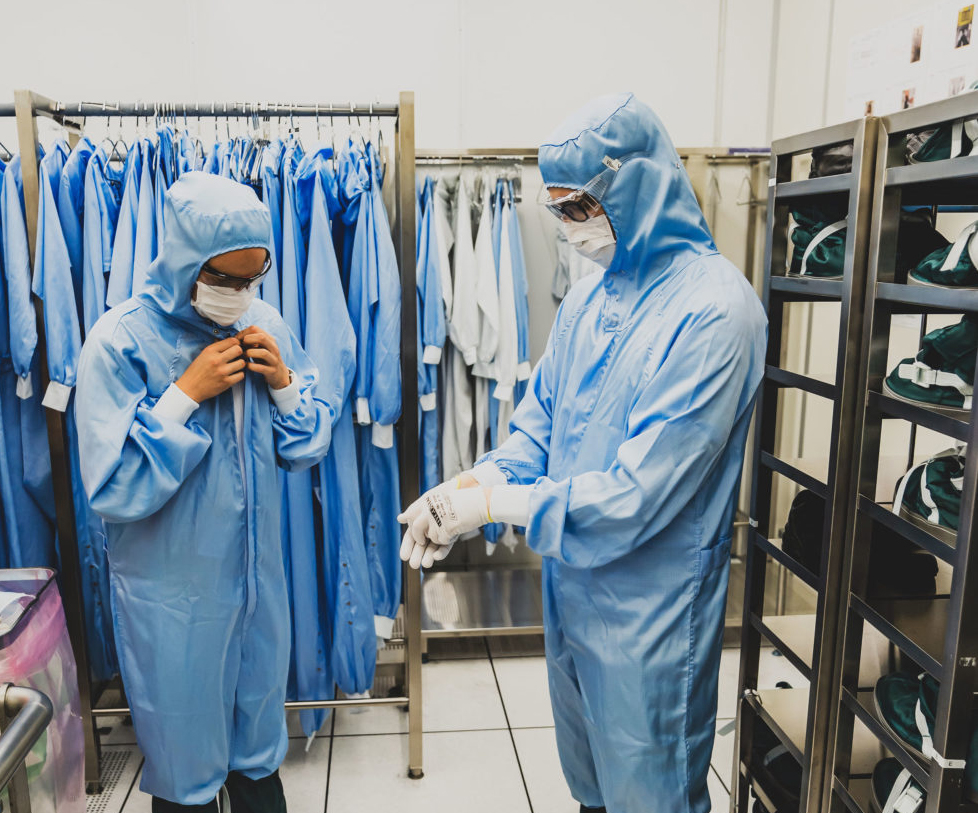Muratan tuotannossa työskentelevät operaattorit ja tuotannon tuen työntekijät työskentelevät laboratorioita muistuttavissa puhdastiloissa. Muratan tuotantotyötä siistimpää työtä saa siis hakea! Mutta miksi työskentelyn täytyy olla niin puhdasta ja mitä puhtausvaatimukset edellyttävät esimerkiksi työasulta?
Turvallisuuskriittiset tuotteet vaativat erityisiä valmistusolosuhteita
Muratalla valmistettavat anturit päätyvät monenlaisiin ihmisten elämänlaatua parantaviin sovelluksiin. Antureitamme käytetään paljon esimerkiksi sydämentahdistimissa, autojen turvallisuusjärjestelmissä sekä yhä enenevissä määrin myös itseohjautuvan ajamisen sovelluksissa.
Koska tuotteitamme hyödynnetään turvallisuuskriittisissä sovelluksissa, ovat myös tuotannon laatuvaatimukset korkeat. Ja jotta tuotanto voi toimia laadukkaasti, edellyttää se erityisiä valmistusolosuhteita. Puhdastilassa pystymme parhaiten suojelemaan valmistamiamme pikkuruisia, huipputarkkoja MEMS-antureita esimerkiksi lialta ja pölyltä, jotka tuotteisiin päästessään vahingoittaisivat niitä.
Puhdastilat ovat nimensä mukaisesti erityisen puhtaita tiloja, joiden ilmanpaine on kovempi kuin puhdastilaa ympäröivillä alueilla. Puhdastiloissa kontrolloidaan ilmassa esiintyvien partikkeleiden eli erittäin pienten hiukkasten syntymistä ja pääsyä puhdastilaan. Muratan Suomen yksikössä käytössä on neljän puhtausluokan puhdastiloja: ISO 4, ISO 5, ISO 6 ja ISO 8, joista ISO 4 on puhtain.
Työasu ja työntekijän toiminta puhdastilassa
Tiesitkö, että puhdastilassa suurin partikkeleiden lähde ovat siellä työskentelevät ihmiset? Partikkeleiden minimoiminen asettaakin tiettyjä vaatimuksia myös työasulle, ja siksi puhdastiloissa pukeudutaan erityisiin suojavarusteisiin.
Työntekijät suojaavat kasvonsa ja hiuksensa mm. suusuojalla, suojalaseilla sekä myssyllä. Työasuun kuuluvat myös koko vartaloa suojaava puhdastilahaalari sekä erityiset puhdashuonekengät, jotka napitetaan kiinni haalarin lahkeeseen. Lopuksi kädet suojataan nitriilikäsineillä ennen puhdastilaan siirtymistä. Näillä suojavarusteilla voidaan minimoida ihmisestä irtoavien partikkeleiden määrä tuotannossa. Kuvassa näet tyypillisen puhdastilassa käytettävän työasun.
Partikkeleiden määrää minimoidaan myös muilla keinoin. Puhdastiloissa ei esimerkiksi saa käyttää meikkiä tai lyijykynää, eikä sinne saa viedä pahvia. Puhdastilassa työskennellessä myös rauhallinen liikehdintä on valttia, sillä sekin on yksi keino vähentää tilassa syntyviä partikkeleita. Puhdastila-alueelle ei myöskään voi viedä henkilökohtaisia tavaroita tai esimerkiksi omaa kännykkää, sillä myös niistä leviävät hiukkaset olisivat riski tuotteille.
Puhdastilaa puhtaampaa työpaikkaa onkin hankala kuvitella. Näissä erityisolosuhteissa valmistuvat huippulaadukkaat anturit, jotka pitävät autot tiellä ja sydämet sykkimässä.
Niko Kuusisto, operaattoreiden kouluttaja



